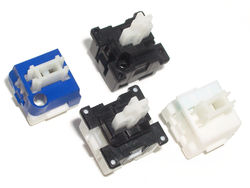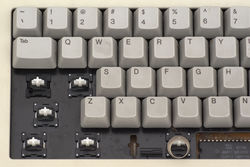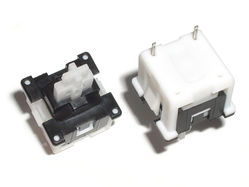Mitsumi standard mechanical
| This article requires additional photographic illustration — need pictures of additional variants |
 | |
| Manufacturer | Mitsumi |
|---|---|
| Switch type | Linear, tactile, latching |
| Sense method | Metal leaf |
| Keycap mount | Alps mount, Mitsumi mount, proprietary cruciform |
| Switch mount | Plate mount |
Mitsumi standard mechanical is a provisional name for a range of typical size discrete mechanical switches from Mitsumi. The name differentiates them from the Mitsumi miniature mechanical switch. The Alps mount version was formerly known as Mitsumi Alps clone, even though it is not an Alps clone switch.
Contents
Description
Mitsumi standard mechanical switches have the same vertical and horizontal return spring orientations as the miniature mechanical switch. They have a simplified switchplate for the electrical contacts. A second pair of holes in the base implies potential support for a DPST arrangement.
Mitsumi branding appears on the base of the switch.
Specifications
No Mitsumi literature has ever been recovered. The Amiga 1000 keyboard specifications on the schematic diagram cite the following:
| Characteristic | Value |
|---|---|
| Operating force | 50 gf |
| Maximum force | 60±20 gf |
| Travel | 4±0.5 mm |
| Off region | 1.3 mm |
| Intermediate region | ~1.4 mm |
| On region | 1.3 mm |
| Lifetime | 10 M |
| Bounce time | 5 ms maximum (at normal pushing) |
Generations
There are two generations of Mitsumi standard mechanical, differing primarily in size. The internals of the two generations are identical.
Type 1
Type 1 switches, the first generation, have a tall cruciform slider and an upper shell with a matching guide shaft. There are no standoff nubs on the base of the switch. All known Type 1 switches are linear, though some such as in the TONO Theta-7070 include late actuation tactile "linears" due to a stiff sensing leaf.
The latching variety has been found in the Commodore 64C, introduced in 1986, while the original Commodore 64 keyboard used a curious switch with PCB protrusions for "legs". There is a suggestion here that the latching switch was introduced after 1982 (when the Commodore 64 was introduced) and by 1986.
The late linear variety can be found on old boards such as the TONO Theta-7070. It possesses a white cap, cruciform mount, and a sense leaf stiff enough to present tactility more than halfway down the keystroke.
From the same board comes the yellow cap variant which is a light version of the linear switch. Any tactility from this sense leaf is negligible and it appears to be completely linear.
Type 2
Type 2 switches, the second generation, are simply a size reduction, likely to make them DIN-compliant. For maximum reduction in size, a negative mount slider was chosen, using the Mitsumi mount. They were also made with Alps mount sliders for Apple keyboards.
Type 2 switches are plate and PCB compatible with Type 1, and the switchplates are identical. Most momentary Type 2 switches are tactile, using two different approaches. The Mitsumi mount switches found in Commodore Amiga computers use an underslung return spring, just as with Mitsumi miniature mechanical. The Alps mount switches used by Apple in the Apple Extended Keyboard II use a modified contact actuator leaf that causes it to behaves like a tactile leaf. This latter design feels very tactile when tested loose, but under typing conditions the tactility is very faint.[1][2] As a result of the low effective tactility, it appears that the actuator leaf adaptation was always overlooked.
Evolution
Type 1 switches all appear to have a blue switchplate. Type 2 switches are found with both blue and white switchplates. The Mitsumi-mount type 2 switches found in the Amiga 1000 have been documented as having blue switchplates[3], while the same switch as shown below uses white switchplates of a design not seen elsewhere.
It would appear that blue switchplate were still in use at the start of the 1990s, but the point at which the colour changed to white isn't certain. Pictures from rzwv and MouseFan of the Apple Extended Keyboard II suggest that the change occurred around 1991; rzwv's 1993 Apple IIe keyboard with type 1 switches still has blue switchplates, but these switches may be old stock. The anomalous switchplate design below is found in switches being sold off via AliExpress, suggesting that the switches may be more recent, and the switchplate redesign may have occurred towards the end of the lifetime of the series. Presently there is not enough data to be certain of this.
Variants
The Tono Θ-7070 terminal keyboard has PCB code KAM-A66YN, suggesting KAM Type for at least part of type 1; it remains unknown whether the base type (e.g. KAM) covers alternate action and double action switches, or whether they would be (say) KAA and KAD Type respectively. "M" appears to denote "momentary" or "mechanical" and appears to be used in the linear metal contact types. The Mitsumi-made Commodore Amiga 1000 keyboard has KCT-A89YC written on the PCB, suggesting that those switches are KCT Type. Comparing with miniature mechanical's KLM (linear) and KLT (tactile) types, KCM Type is implied for the linear type 2 switches, with KCT thus denoting the tactile types.
| Type | Belongs to |
|---|---|
| KAM | Type 1 |
| KCT | Type 2, tactile |
Known variants of this series are:
| Generation | Mount | Switch type | Part number | Notes | |
|---|---|---|---|---|---|
 |
Type 1 | Cruciform | Linear | ||
 |
Type 1 | Cruciform | Linear | As above, but with white shell[4] | |
 |
Type 1 | Cruciform | Linear, low force | Yellow shell; used in pairs for wide switches and edge switches[4] | |
 |
Type 1 | Cruciform | Latching | ||
 |
Type 1 | Cruciform | Double action | Mitsumi standard mechanical double action | |
 |
Type 2 | Mitsumi | Tactile | E25-33-137 | Anomalous switchplate |
 |
Type 2 | Mitsumi | Tactile+LED | Anomalous switchplate | |
 |
Type 2 | Mitsumi | Linear? | Monterey K7S normal keys | |
 |
Type 2 | Mitsumi | Heavy linear? | Monterey K7S space bar | |
 |
Type 2 | Mitsumi | Latching+LED? | Monterey K7S caps lock | |
 |
Type 2 | Alps | Tactile | ||
 |
Type 2 | Alps | Latching+LED | ||
 |
Type 2 | Alps | Latching+LED |
Keyboards
- Apple IIe Enhanced (type 1)[5]
- Some Apple M0110A keyboards (type 1)
- Some Apple Extended Keyboard II (type 2, Alps mount)
- CCE MC-4000 (Exato IIe) (type 2, Mitsumi mount, likely at least two types; not confirmed)[6]
- Some Commodore Amiga 1000 keyboards (type 2, Mitsumi mount; from 1985)
- Commodore 64C (type 1 latching)
- Monterey K7S (type 2, Mitsumi mount; not confirmed — three different switch types; ca. 1986 example)
- Tono Θ-7070 terminal keyboard (linear with colourless shell; yellow low force; 1986 example)[4]
- Sears The Electronic Communicator 2 (Type 1, 4 different types. Linear with white shell, Linear with black shell and LED hole, Linear DPST with white shell, Linear low-force with yellow shell.)
- Olympia electronic compact 2 (Type 1, 3 different types. Linear with white shell, Linear with black shell and LED hole, Double action with white shell.)
Disassembly
The plate retention clips on each side are part of a plastic bar. This bar also holds down the top of the switch. To open the switch, insert a long, flat implement underneath the plate retention clip on one side, and gently lever the bar away until the top of the switch is released; it will move around 1 mm or so. Turn the switch over and do the same with the other side. This does not require a high amount of force and the switch should open cleanly.
Gallery
Type 1
Type 1 switches, including Mitsumi standard mechanical lock
Type 2
References
- ↑ Mousefan – AppleExtendedKeyboardⅡ M3501 MITSUMI JAPAN 91 (Japanese only) Dated 2004-10-10. Retrieved 2015-07-29.
- ↑ ちゃたりたいね — Apple Extended Keyboard II M3501 JAPAN MITSUMI軸 (Japanese only) Dated 2013-03-22. Retrieved 2015-07-29.
- ↑ geekhack — Amiga 2000 Cherry Keyboard
- ↑ 4.0 4.1 4.2 geekhack — What is this, a tactile Mitsumi Type 1? Tono Θ-7070 terminal
- ↑ ちゃたりたいね — Apple IIe MITSUMI十字白軸 リニア (Japanese only) Dated 2014-02-28. Retrieved 2015-07-29.
- ↑ 1000 BiT — Computer's description













